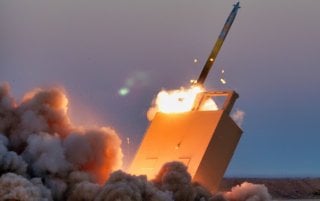GMLRS: The 'Advanced Munition' the Army Can't Do Without
The U.S. Army has expanded its contract with Lockheed Martin by $3.4 billion for the Guided Multiple Launch Rocket System (GMLRS), highlighting its crucial role on the modern battlefield, especially in Ukraine.
Summary and Key Points: The U.S. Army has expanded its contract with Lockheed Martin by $3.4 billion for the Guided Multiple Launch Rocket System (GMLRS), highlighting its crucial role on the modern battlefield, especially in Ukraine.
-Three versions of the GMLRS exist: the GMLRS Unitary, the GMLRS Alternative Warhead, and the Extended Range GMLRS, with ranges up to 93 miles.
-Ukraine's use of GMLRS with M142 HIMARS and M270 MLRS has been highly effective against high-value Russian targets.
-The conflict has reaffirmed artillery's importance in warfare, with artillery fire causing over 80% of the estimated 1 million casualties on both sides.
U.S. Army Boosts GMLRS Contract: The Artillery Powerhouse in Modern Warfare
The U.S. Army added $3.4 billion to an ongoing contract with Lockheed Martin for one of the most important munitions on the modern battlefield.
The Guided Multiple Launch Rocket System, or GMLRS, is a powerful artillery rocket, and the Army wants more.
An Expanding GMRLS Contract
The Pentagon has been pouring money into this contract for several years now as demand for GMLRS munitions continues to grow. This artillery munition has been key in the fighting in Ukraine, showing its value in modern combat.
There are currently three versions of the GMLRS: the GMLRS Unitary munition, the GMLRS Alternative Warhead, and the Extended Range GMLRS, which is in development.
The GMLRS Unitary munition packs a 200 lbs warhead and has a range of around 45 miles. It is best used against individual high-value targets.
The GMLRS Alternative Warhead also packs a 200 lbs warhead and has a range of around 45 miles but is designed for area targets, and its warhead is designed to fragment on impact.
Finally, the Extended Range GMLRS is a new, developmental version of the munition that has the same warhead as the other versions but offers an extended range of about 93 miles.
According to Lockheed Martin, the GMLRS has a reliability rating that exceeds 98%. As such, out of the approximately 60,000 munitions manufactured, only slightly over 1,000 have presented issues.
The GMRLS in Action
The GMLRS has been playing a key role in Ukraine’s defense against Russia. The munition is used primarily by the M142 High Mobility Artillery Rocket Systems, or HIMARS, and the M270 Multiple Launch Rocket System, or MLRS. The Ukrainian military has used its relatively medium fleet of M142 HIMARS and M270 MLRS (around 55 vehicles of both types) to great success, destroying command and control centers, ammunition depots, troop concentrations, air defense systems, and radar installations, among other high-value targets.
The combination of the M142 HIMARS’ and M270 MLRS’ flexibility with the operational range of the GMLRS is a powerful tool in the hands of a military commander. In many cases, an M142 HIMARS or M270 MLRS can fire a salvo of GMLRS and be on its way to a hiding spot before the munitions even reach the target, thus making counter-artillery against the vehicles very difficult.
The war in Ukraine has highlighted the value of artillery in modern combat. It has been over 200 years since French Emperor Napoleon Bonaparte declared artillery to be the “king of the battle,” and artillery fire continues to be the deadliest weapon on a near-peer battlefield. Intelligence assessments from the Ukrainian conflict indicate more than 80% of casualties on both sides are caused by artillery fire. Considering that total casualties (killed and wounded) for both the Russian and Ukrainian military are hovering around 1 million, we are talking about approximately 800,000 casualties caused by artillery fire.
About the Author
Stavros Atlamazoglou is a seasoned defense journalist specializing in special operations and a Hellenic Army veteran (national service with the 575th Marine Battalion and Army HQ). He holds a BA from the Johns Hopkins University and an MA from the Johns Hopkins’ School of Advanced International Studies (SAIS). His work has been featured in Business Insider, Sandboxx, and SOFREP.


